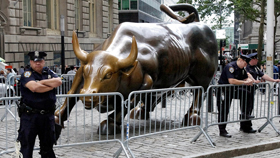Forecasting global finance in the midst of a global crisis is both fascinating and precarious. There seems to be no other field of human activity where opinions are as diverse as in the financial realm, partly due to the problems’ scale and partly because of experts' preferences, but mainly as a result of the overall uncertainty inherent in the financial sector.
Frequently, the temptation to anticipate a looming crisis or nascent boom is so great and the interest in predictions is so high that one's attention becomes riveted to marketing forecasts based on accepted approaches to technical and fundamental analysis, or on more exotic concepts, from Elliott Wave Theory to Kondratieff’s long waves. Although the latter method was laid to rest back in the late 1980s, it remains uncharted territory for many Russian commentators.
Meanwhile, much more valuable for long-term forecasting is not market-oriented but rather draws on the global financial system’s structure, i.e. basic elements of the global financial architecture that will define the direction and quantitative parameters of financial flows’ future dynamics. Scenario-based forecasting in this area resembles a prediction of architectural styles – pompous or minimalist, functionally unified or adapted to particular conditions and needs – that are determined by the clients’ (market entities’) requirements or by regulatory norms. The answers should come from combinations of key elements specific to each scenario (style) pertaining to the global financial architecture’s development.
In Search of Style Elements
Analysis of the international financial system and the debate on its improvement make it possible to discern the following basic style elements, which will, when chosen, shape the different scenarios for the global financial architecture’s evolution.
Proportions of the Financial Sector Development. In recent years variations on a theme of “the financial sector has distanced itself from its mission of serving the real economy” have become a mantra. However, this primarily refers to the financial derivatives segment. In late 2011, aggregate banking assets accounted for a half the global GDP, while the volume of the financial institutions’ and the corporate sector’s securitized obligations amounted to slightly more than one third of global GDP. At the same time, the amount of traded financial derivatives exceeded global GDP more than ninefold [1]. And it is the derivatives' market rapid development that seems most worrisome as a potential source of future global financial instability.
Mechanisms for Regulating Financial Operations. As a rule, these mechanisms come into the limelight in a discussion of the future reforms to the international financial architecture [2]. Aside from institutional issues pertaining primarily to international intergovernmental organizations’ and clubs’ regulatory authority (i.e. the IMF, World Bank, Basel Committee on Banking Supervision, FATF, G7, and G20) and certain countries’ ability to influence their procedures, there are numerous issues of equal significance. Among them, relationships between national, regional and global regulators; nongovernmental entities’ participation (if possible) in financial market regulation; and, above all, the tempo for closing the gap (if viable) in regulation intensity between various segments of the financial markets [3].
Reserve Currencies. The possible emergence of new reserve currencies raises a major long-term intrigue in global finance. While in the coming 10-15 years the U.S. dollar, which in 2011 accounted for 62 percent of aggregate international reserves, about 60 percent of international deposits and over 58 percent of accumulated international debt [4], does not seem to face any visible threat, the future remains uncertain. The euro and renminbi are the most likely candidates for level-one reserve currency status in the next 30-50 years. However, issuing countries’ economic weakening (or currency wars between them) might cause the formation of regional currency pools that offer effective competition to level-one reserve currencies.
The development of international financial centers is currently influenced by diverse trends. On the one hand, emerging economies’ financial centers increasingly aspire to the status of global (Shanghai, Dubai) and regional (Kuala Lumpur, Warsaw, Johannesburg) financial hubs. On the other, growing pressure on offshore financial centers significantly hampers their development, although they remain vital for the world economy and their existence meets the interests of most states, including those leading the campaign for offshore transparency and manageability. Should this tendency strengthen in the coming decades, we may witness a radical change in the geography of global financial centers, which are currently located in industrialized countries and key tax havens.
With the style elements at hand, we can generate combinations of these factors under the main development scenarios for the global financial system.
Steel and Glass: More Unification – More Transparency
As far as the global financial architecture’s evolution is concerned, the above stylistic direction is related to preserving the strategic approach from the mid-1990s, which involves a radical reduction of stability risks through unifying regulations and monitoring mechanisms (steel) and greater transparency of financial operations (glass). The trend rests on the Dodd-Frank Wall Street Reform and Consumer Protection Act of 2010, the Third Basel Accord on resilience standards for banking institutions (Basel III, 2010–2011), and proliferating bilateral agreements with offshore centers on information exchange. Industrialized countries should retain their main regulatory controls, despite certain concessions to emerging economies, as shown by the latest IMF and World Bank reforms. At the same time, financial markets in industrialized and developing countries should converge in both maturity level and institutional quality, with a consolidation of the main market platforms such as exchanges and OTC markets, and clearing and depository organizations [5].
Establishing efficient mechanisms to regulate the derivatives market seems to be of principal importance under this scenario. Neutralizing the derivatives market’s instability while protecting its broader viability must be key to any attempt to improve on the pre-crisis international finance model. If this market escapes radical reform, any global financial structure styled in steel and glass is, in the long term, doomed to collapse under further – probably even more disastrous – financial crises. This reform has yet to take shape, and could become a trump card under Russia's G20 presidency in 2013.
Financial Baroque: More Diversity, Fewer Standard Solutions
This scenario also suggests that the global financial system’s development maintains its momentum, although not through unification, as prescribed by the steel-and-glass setting, but via further diversification of: 1) market instruments and financial market regulators; 2) market participants and entities involved in making regulatory decisions; 3) institutions operating in financial markets; and 4) currencies servicing operations (reserve currencies included).
This scenario would also involve breaking state players’ monopoly in regulatory functions via engaging knowledgeable market players and international rating agencies that have information inaccessible to state bodies [6]. Another important style element lies in the growing competition among the currencies of those countries eager to expand their presence in the banking sector and push back the U.S. dollar. (Under this scenario, the USD share in international deposits, international credits and reserves may fall to 40-45 percent in 20 years.) On the one hand, this competition should expand the choice of currencies for operations and asset placement, but on the other, additional risks could emerge as a result of currency wars and exchange rate fluctuations of sovereign currency reserves.
Ways to diminish risks under this scenario also involve growing diversification of regulatory mechanisms, including establishing bilateral and regional collaboration frameworks for finance (supranational regulatory bodies, regional standards for financial institutions) and currency (coordination of currency policies, currency unions, currency swaps). As fears of fresh outbursts of currency instability remain [7], there is unlikely to be unanimous support for implementing such complex systems. However, in 20-30 years’ time their attraction may grow noticeably, both for market players searching for effective niche strategies for international expansion, and for countries featuring markedly specific financial systems (countries in the Arab world, for example) or those striving to achieve higher ratings within international financial centers.
Financial Minimalism: Overall Control – Nothing in Excess
In contrast to the above scenarios, this approach involves regulators chiefly attempting to eliminate sources of instability that relate to financial market operation, including through a radical contraction of the markets' functions and rigid control over participants. On the one hand, the appropriate motivation may arise from the countries’ individual experiences of applying restrictions to financial operations as a damage limitation measure in the crises of 1998-1999 (Malaysia) and 2008-2009 (China). On the other, public aversion to the Wall Street fat cats is leaving its mark on world leaders’ rhetoric in the recent turmoil (especially in 2008-2009), may push governments to radically toughen regulatory regimes. First of all, this could hit the banks (due to the traditionally ghastly image of bankers in times of financial crisis) and derivatives markets (including commodity markets), to prevent the harmful impact of financial speculation on commodity and food prices. Besides, additional restrictions could be imposed on transborder capital operations, including carry trade, to cut hot money flows.
The biggest threat in this scenario lies in “throwing the baby out with the bathwater.” Rhetoric about "making the financial sector serve the real economy" usually conceals a negation of the financial agents' role in mobilizing and, above all, generating financial resources. Although most of the more extreme attempts to push the system in this direction – such as the notorious Tobin tax – have been rebuffed, they may rematerialize in future.
Conclusions for Russia
The three long-term (30 years plus) scenarios’ probability is seen as being 40:35:25. For Russia, scenario one and two seem encouraging, although for different reasons. The steel-and-glass architecture (provided the issue of regulating the derivatives markets has been settled) could ensure the global financial markets’ dynamic development and the resulting capital flow into Russia. At the same time, growing unification in regulatory rules and continuing leadership of the U.S. dollar would complicate the establishment of a Russian financial center and the international strengthening of the ruble. On the contrary, the financial baroque scenario gives additional chances to regional currency-based initiatives. However, the reverse side of it involves greater uncertainty about sustainable growth. In any case, Russia can only exploit emerging opportunities by dramatically improving its investment climate, optimizing financial institutions and lowering inflation. Otherwise, Moscow can expect to attain little more than the role of an observer, watching others reap the fruits.
1. Calculated with the help of: IMF Economic Outlook. October 2012 (Table A1); Bank for International Settlements Quarterly Overview. March 2012. Statistical Appendix (Tables 11, 12B, 12C); Bank for International Settlements Quarterly Overview. June 2012. Statistical Appendix (Tables 1A, 4).
1. D.V. Smyslov. Reforming the International Monetary Fund: Problems and Solutions // Dengi I Kredit magazine. 2012. № 1. Pages 36–43 (part 1); Dengi I Kredit magazine. 2012. № 2. Pages 33–44 (part 2).
2. While the banking services are overregulated, operations involving derivatives enjoy the greatest freedom. On the one hand, insufficient regulation of the derivatives market may be regarded as a cause of its rapid and sometimes risky growth, but on the other, the very scale of these operations and the emergence of new derivatives prevent the development of rigid restrictions.
3. During the past decade, the share of USD operations in international currency markets has exceeded 80%. See: Goldberd L. The International Role of the Dollar: Does It Matter if This Changes? // Federal Reserve Bank of New York Staff Report. 2011. October. № 522. Р. 24.
4. Global Strategic Forecast 2030 / Edited by A.A. Dynkin. Moscow: Magistr Publishers, 2011. pages 126–127.
5. S.A. Afontsev. Political Markets and Economic Policies. Moscow: Komkniga Publishers, 2010. Pages 314–318.
6. The latest review of global risks by the World Economic Forum qualifies major financial systemic failures as having the worst impact on the global economy (4.08 on the five-grade scale) with a realization probability of 3.1-3.2. See: World Economic Forum. Global Risks 2012. 7th ed. Geneva, 2012.








